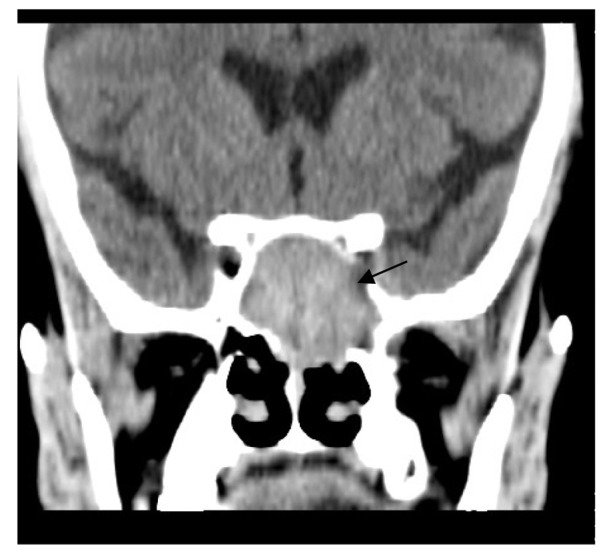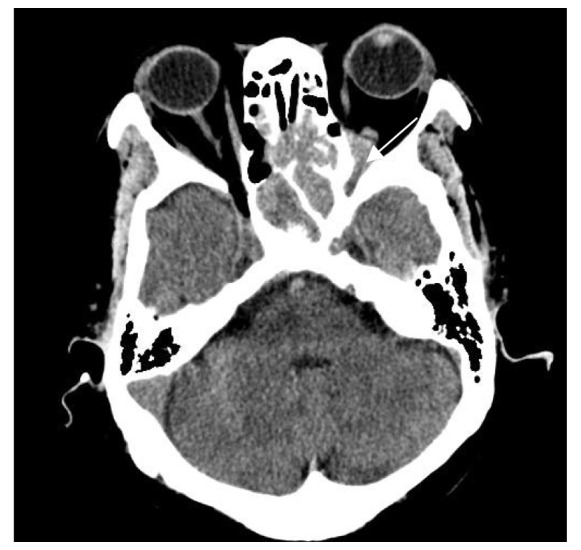Abstract
Primary non-Hodgkin lymphoma (PNHL) of the sphenoid sinus is a rare neoplasm that poses a diagnostic challenge to clinicians. The proximity of the optical nerve and canal to the sphenoid sinus is accountable for the high incidence of visual disturbance in PNHL of the sphenoid sinus. In particular, patients whose radiologic diagnosis reveals bone destruction in the lateral wall involved with optical-nerve-canals or cavernous sinus present a high risk of rapidly developing unilateral blindness. The present study reports 2 rare cases of PNHL of the sphenoid sinus. Sudden sight loss may follow minimally invasive biopsy. In such cases, the measures that must be taken for the prevention of permanent sight loss are limited in the absence of the final pathologic diagnosis.
Keywords: primary non-Hodgkin lymphoma, sphenoid sinus, visual disturbance
Introduction
Sinonasal lymphomas are very rare in western countries, but rather common in Asia (1). Primary malignant lymphomas of the paranasal sinus account for ~8% of all paranasal malignancies globally (2). The sphenoid sinus is a rare primary site for extranodal lymphomas (3). Nonspecific clinical signs and symptoms of malignant lymphomas of the sphenoid sinuses include recurrent sinusitis, nasal discharge, headache and sight loss (4). Insufficient biopsy material may lead to the misdiagnosis of the disease, since histology specimens are usually obtained via the transnasal endoscopic approach; therefore, the diagnosis of sinonasal lymphoma comprises a challenge for clinicians (5). If the patient has symptoms of visual disturbance, obtaining an adequate amount of biopsy tissue, while also avoiding to compromise the sight of the patient is rather difficult (3). The present study reports 2 cases of primary malignant lymphomas of the sphenoid sinus that were treated differently, which resulted in different outcomes.
Case report
Case 1
A 55-year-old female patient visited the outpatient office of The Affiliated Baiyun Hospital of Guizhou Medical University (Guiyang, China) on October 2012, presenting with a 3-month history of headache without nasal discharge. The patient had no history of fever, weight loss, nocturnal sweating or sight loss. Computed tomography (CT; SOMATOM Definition AS; Siemens Healthcare GmbH, Forchheim, Germany) and magnetic resonance imaging (MRI) scans (MAGNETOM Symphony 1.5T System; Siemens Healthcare GmbH) demonstrated a homogenous soft-tissue lesion occupying the left sphenoid sinus and invading the left cavernous sinus (Fig. 1). The patient received minimally invasive biopsy of tissue obtained from the left sphenoid sinus in the Department of Otorhinolaryngology, Head and Neck Surgery of The Affiliated Baiyun Hospital of Guizhou Medical University. The sample tissue was described as a red, friable, vascular tumor. Intraoperative frozen section diagnosis was suggestive of a small round cell tumor. In the next 3 days, the patients headache gradually improved, but the patient developed sudden and complete visual loss in the morning of the fourth day. Despite conservative therapy with a high intravenous dose of methylprednisolone (500 mg intravenously; Pfizer, Inc., New York, NY, USA), vision was not recovered.
Figure 1.

Computed tomography scan revealing a homogenous soft-tissue lesion occupying the left sphenoid sinus and invading the left cavernous sinus (black arrow).
The final histological diagnosis was diffuse large B-cell type PNHL. The patient was referred to the Medical Oncology Clinic of Guizhou Medical University (Guiyang, China) for a staging work-up, and received chemotherapy [standard 6 cycles of cyclophosphamide (750 mg/m2 intravenously), hydroxydaunorubicin (50 mg/m2 intravenously), oncovin (1.4 mg/m2 intravenously) and prednisone (100 mg/day orally) chemotherapy with adjuvant rituximab (375 mg/m2 intravenously); Bristol-Myers Squibb, New York, NY, USA] combined with 40 Gy radiotherapy. At the time of writing the present study, the patient had been disease-free for 3 years and received monthly follow-ups in the Medical Oncology Clinic of Guizhou Medical University.
Case 2
A 72-year-old female patient was admitted to The Affiliated Baiyun Hospital of Guizhou Medical University on September 2013 presenting with headache and blurred vision on the left eye for 1 month, in addition to ptosis. The patient had a history of chronic lymphocytic leukemia (CLL), which had manifested 7 years prior to admission to hospital, and had been treated with 4 cycles of fludarabine (25 mg/m2 intravenously)/cyclophosphamide (250 mg/m2 intravenously). The best corrected visual acuity was determined by counting fingers on the left eye with mydriasis. Bone marrow biopsy detected evidences of recurrence of leukemia. CT and MRI scans of the brain and visual orbits demonstrated a mass occupying the left sphenoid sinus with orbital apex involvement (Fig. 2); however, the clinician faced the challenge of how to rescue the visual sight without the final pathology result, which normally requires 4–5 days to be identified. Based on the experience obtained from case 1, where the suffering of the patient increased following endoscopic sinus biopsy, it was considered that the possibility of sight loss would be greater if the standard procedure was followed, that is, if chemotherapy was started 3–4 days after the final pathological diagnosis. Following a discussion with a hematologist in The Affiliated Baiyun Hospital of Guizhou Medical University, it was suggested that, due to the patients history of CLL, rituximab would be administered following surgical biopsy to prevent sight loss.
Figure 2.

Computed tomography scan of the brain showing a mass occupying the left sphenoid sinus with orbital apex involvement (white arrow).
Following the consent of the patient, a single dose of rituximab (375 mg/m2) was administered intravenously following surgical biopsy. As a result of the treatment, the mydriasis in the left eye was partly resolved on the morning of the second day. No enhancing nerve lesion was observed during follow-up examination, and her vision returned to baseline on the seventh day. The final histological diagnosis was diffuse large B-cell type PNHL, which was positive for cluster of differentiation (CD)20 (mouse monoclonal; dilution, 1:100; cat no., M0755; Dako, Glostrup, Denmark) and negative for CD3 (mouse monoclonal; dilution, 1:80; cat no., M7254; Dako). Immunohistochemistry was performed as previously described (6). The patient received standard cyclophosphamide, hydroxydaunorubicin, oncovin, prednisone chemotherapy with adjuvant rituximab, as described for case 1. At the time of writing the present study, the patient was receiving monthly follow-ups and chemotherapy.
Discussion
Tumors of the sphenoid sinus are seldom associated with symptoms such as nasal obstruction, epistaxis or nasal discharge. By contrast, common symptoms include headache and various other cranial neuropathies (7,8). The vital anatomical regions in the vicinity of the sphenoid sinus are commonly affected by this type of tumors (4).
The 2 cases described in the present study are rather unique, since the patient from case 1, who did not present with visual disturbance, lost her sight following surgical biopsy, whereas the patient from case 2, who presented with visual disturbance, did not experience the same outcome, possibly due to the differences type of intervention. PNHL of the sphenoid sinus poses a series of challenges to clinicians, due to its nonspecific symptoms and unique anatomical sites of occurrence (9).
Previous studies have reported that T-cell and natural killer/T-cell lymphomas mainly occur in the nasal cavity, whereas B-cell lymphomas commonly occur in the sinus without nasal disease (10,11). Clinically aggressive lymphomas, including Burkitt's lymphoma and diffuse large B-cell lymphoma of the sphenoid sinus, exhibit atypical characteristics, including destruction of adjacent bone such as the skull base and infiltration of the dura mater with intracranial invasion (12). To the best of our knowledge, only a few cases of PNHL of the sphenoid sinus, including the present ones, have been reported in the English literature to date (13). Half of the reported patients presented with visual disturbance. Thus, PNHL of the sphenoid sinus should be suspected if a patient presents with a mass in the sinus and visual disturbance.
The association between surgical biopsy and vision loss has not yet been established (14). In cases of sudden vision loss, paranasal lymphoma involving the optical nerves should be considered, in addition to compression of the optical nerve, as a possible cause (9). The conclusion drawn from the outcomes of the present and previous studies is that even minimally invasive biopsy may cause vision loss in patients with PNHL of the sphenoid sinus. Furthermore, radiological evidence of bone destruction in the lateral wall of the sphenoid sinus in patients with no complaints of visual disturbance should be concerning.
In the present study, case 1, who did not present with visual disturbance, lost her sight following surgical biopsy, whereas case 2, who presented with visual disturbance, did not suffer the same result, possibly due to aggressive intervention. In clinical practice, it is known that definite histological diagnosis is required prior to the initiation of any treatment. The proximity of the vital optical nerve to the sphenoid sinus is responsible for the high incidence of visual disturbance in patients with lymphomas of the sphenoid sinus (15). It remains controversial whether or not patients with a very strong clinical suspicion of lymphoma should receive aggressive lymphoma treatment to prevent or recover certain complications (16). Therefore, the establishment of the optimal treatment option for such patients is required.
References
- 1.Abbondanzo SL, Wenig BM. Non-Hodgkins lymphoma of the sinonasal tract. A clinicopathologic and immunophenotypic study of 120 cases. Cancer. 1995;75:1281–1291. doi: 10.1002/1097-0142(19950315)75:6<1281::AID-CNCR2820750610>3.0.CO;2-I. [DOI] [PubMed] [Google Scholar]
- 2.Yasumoto M, Taura S, Shibuya H, Honda M. Primary malignant lymphoma of the maxillary sinus: CT and MRI. Neuroradiology. 2000;42:285–289. doi: 10.1007/s002340050887. [DOI] [PubMed] [Google Scholar]
- 3.Lee H, Choi KE, Park M, Lee SH, Baek S. Primary diffuse large B-cell non-Hodgkin lymphoma of the paranasal sinuses presenting as cavernous sinus syndrome. J Craniofac Surg. 2014;25:e338–e339. doi: 10.1097/SCS.0000000000000597. [DOI] [PubMed] [Google Scholar]
- 4.Peng KA, Kita AE, Suh JD, Bhuta SM, Wang MB. Sinonasal lymphoma: Case series and review of the literature. Int Forum Allergy Rhinol. 2014;4:670–674. doi: 10.1002/alr.21337. [DOI] [PubMed] [Google Scholar]
- 5.Bhatia A, Saikia UN, Kumar Y, Dey P. Fine needle aspiration cytology of spindle cell variant of diffuse large B-cell lymphoma: A diagnostic dilemma. Cytopathology. 2008;19:197–199. doi: 10.1111/j.1365-2303.2007.00449.x. [DOI] [PubMed] [Google Scholar]
- 6.Mubarak A, Wolters VM, Houwen RH, ten Kate FJ. Immunohistochemical CD3 staining detects additional patients with celiac disease. World J Gastroenterol. 2015;21:7553–7557. doi: 10.3748/wjg.v21.i24.7553. [DOI] [PMC free article] [PubMed] [Google Scholar]
- 7.Alexander FW. Primary tumors of the sphenoid sinus. Laryngoscope. 1963;73:537–546. doi: 10.1288/00005537-196305000-00006. [DOI] [PubMed] [Google Scholar]
- 8.Lawson W, Reino AJ. Isolated sphenoid sinus disease: An analysis of 132 cases. Laryngoscope. 1997;107:1590–1595. doi: 10.1097/00005537-199712000-00003. [DOI] [PubMed] [Google Scholar]
- 9.Roth DB, Siatkowski RM. Bilateral blindness as the initial presentation of lymphoma of the sphenoid sinus. Am J Ophthalmol. 2000;129:256–258. doi: 10.1016/S0002-9394(99)00308-6. [DOI] [PubMed] [Google Scholar]
- 10.Kim GE, Koom WS, Yang WI, Lee SW, Keum KC, Lee CG, Suh CO, Hahn JS, Roh JK, Kim JH. Clinical relevance of three subtypes of primary sinonasal lymphoma characterized by immunophenotypic analysis. Head Neck. 2004;26:584–593. doi: 10.1002/hed.20015. [DOI] [PubMed] [Google Scholar]
- 11.Yen TT, Wang RC, Jiang RS, Chen SC, Wu SH, Liang KL. The diagnosis of sinonasal lymphoma: A challenge for rhinologists. Eur Arch Otorhinolaryngol. 2012;269:1463–1469. doi: 10.1007/s00405-011-1839-9. [DOI] [PubMed] [Google Scholar]
- 12.Bisdas S, Fetscher S, Feller AC, Baghi M, Knecht R, Gstoettner W, Vogl TJ, Balzer JO. Primary B cell lymphoma of the sphenoid sinus: CT and MRI characteristics with correlation to perfusion and spectroscopic imaging features. Eur Arch Otorhinolaryngol. 2007;264:1207–1213. doi: 10.1007/s00405-007-0322-0. [DOI] [PubMed] [Google Scholar]
- 13.Park YM, Cho JH, Cho JY, Huh JS, Ahn JY. Non-Hodgkins lymphoma of the sphenoid sinus presenting as isolated oculomotor nerve palsy. World J Surg Oncol. 2007;5:86. doi: 10.1186/1477-7819-5-86. [DOI] [PMC free article] [PubMed] [Google Scholar]
- 14.Kitthaweesin K, Theerakul T. Neuro-ophthalmic manifestations in sinusitis patients who underwent endoscopic sinus surgery. J Med Assoc Thai. 2012;95:1543–1547. [PubMed] [Google Scholar]
- 15.Inaki S, Okamura H, Chikamori Y. Adult T-cell leukemia/lymphoma originating in the paranasal sinus. Arch Otolaryngol Head Neck Surg. 1988;114:1471–1473. doi: 10.1001/archotol.1988.01860240121037. [DOI] [PubMed] [Google Scholar]
- 16.Touitou V, LeHoang P, Bodaghi B. Primary CNS lymphoma. Curr Opin Ophthalmol. 2015;26:526–533. doi: 10.1097/ICU.0000000000000213. [DOI] [PubMed] [Google Scholar]


